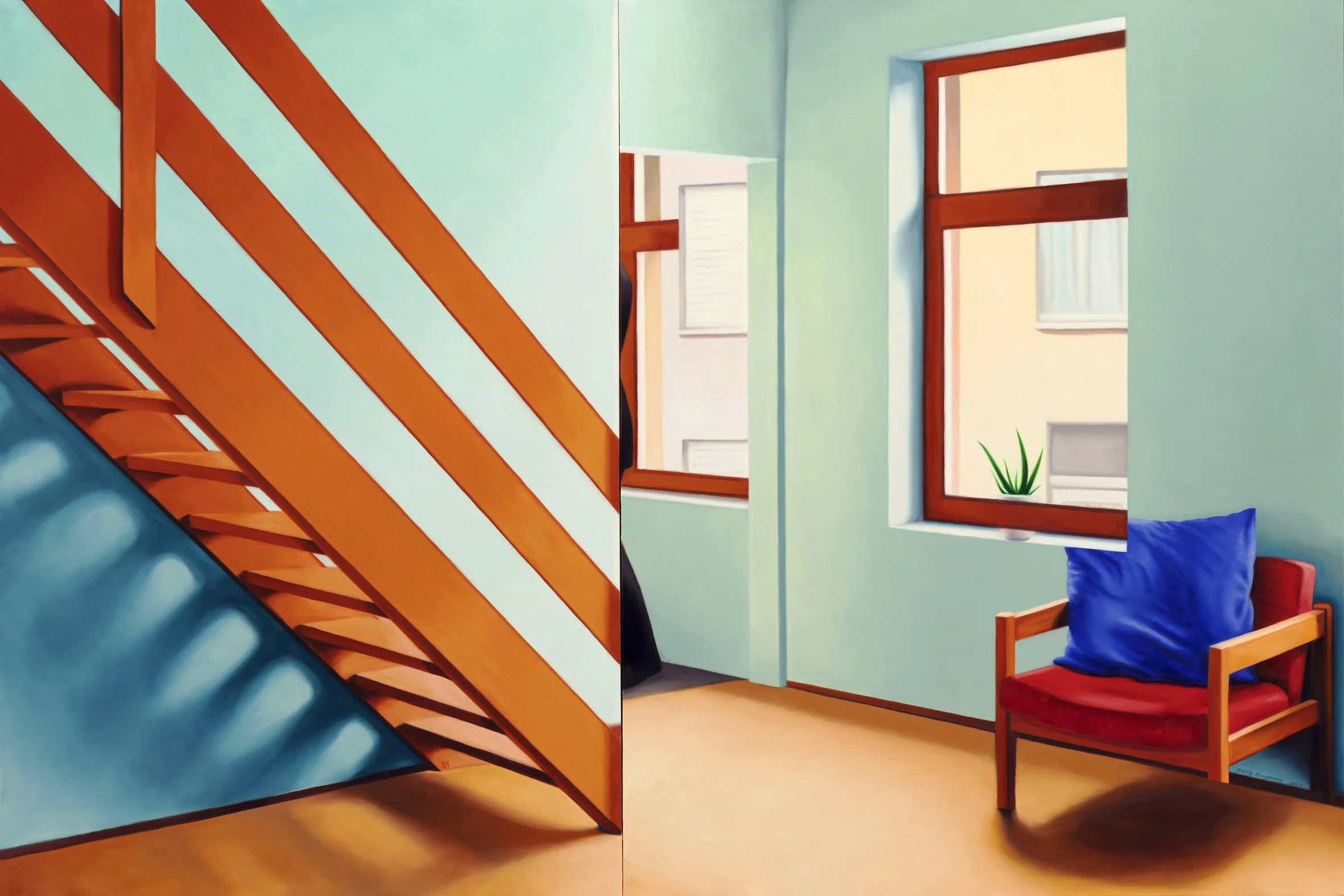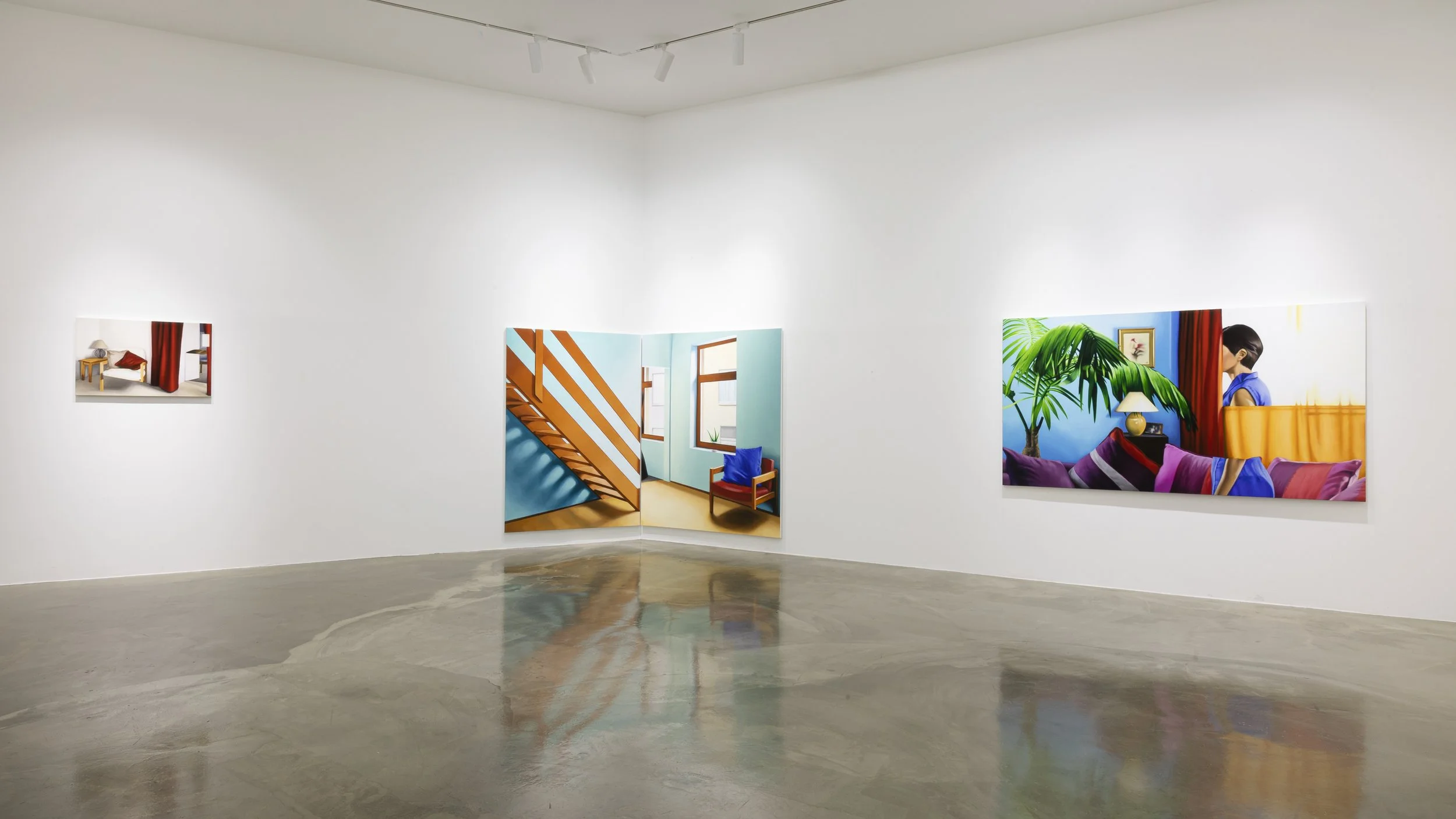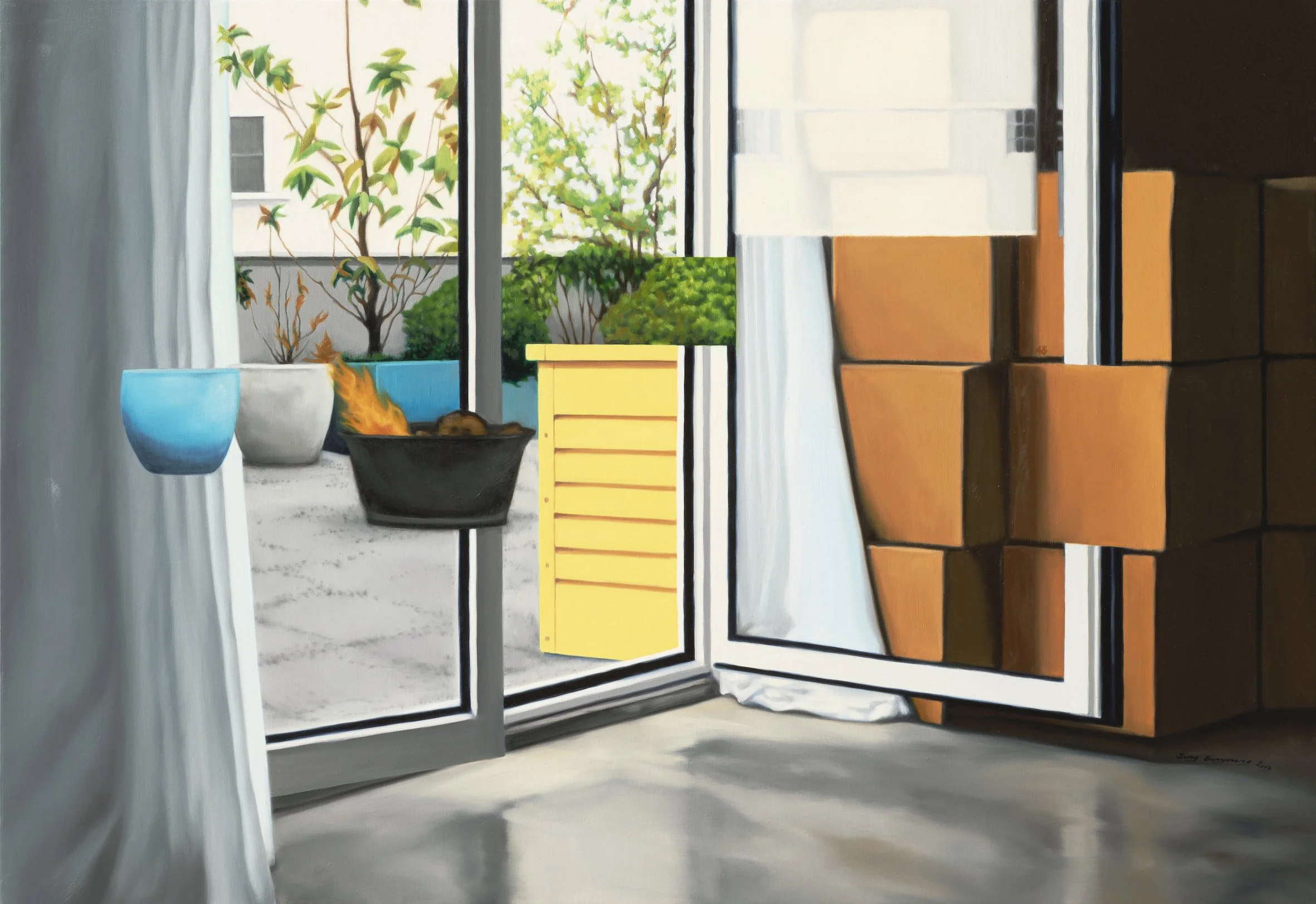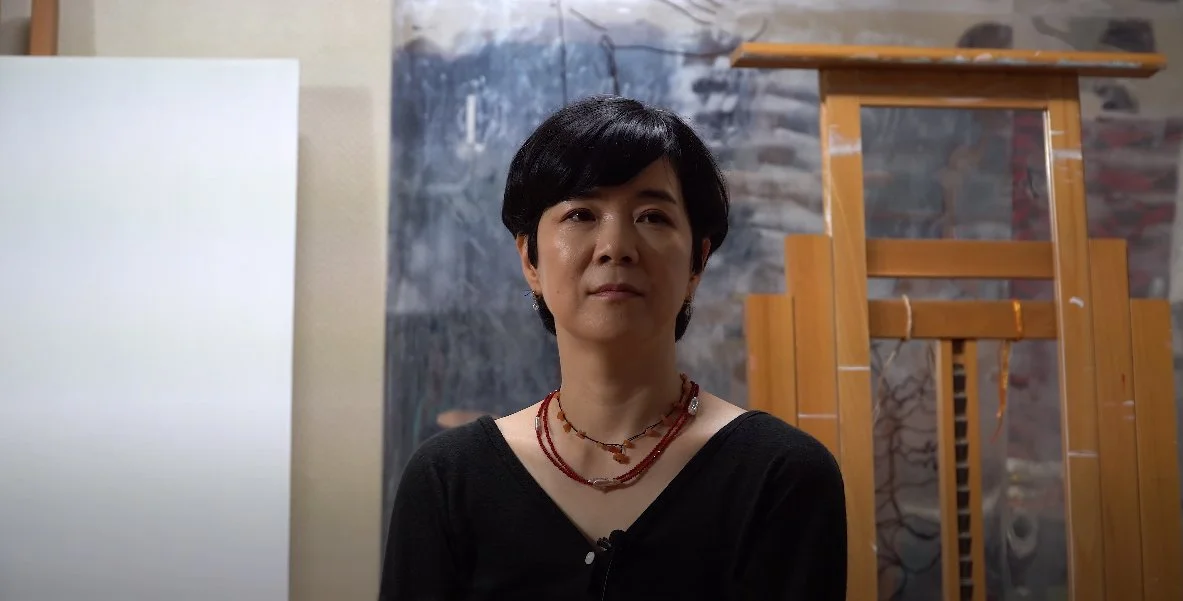Introducing Eunyoung Song (Seoul, KR)
This month, we had a lengthy conversation with Korean artist Eunyoung Song from Seoul (KR). We met her last year during a museum visit and have been struck by her paintings filled with optical illusions and intimate details of the domestic life. We’re proud to share this interview and a selection of works. Please check out vieiwing room on Artsy too.
Song Eunyoung, Scene 9 (Beds), 2009, oil on linen, 38 x 51 in.
Sarah Corona: What are your main sources of inspiration?
Song Eunyoung: My main sources of inspiration derive from the image as a visual structure, the colors I desire to see and feel, and the imagery of unfamiliar spaces created by alternating parts of an image. These elements drive my passion for painting. So, I take countless photos and search for the images I want to create. I also experiment with numerous blends on the palette to find the colors I want to see. After selecting an image, I continue to recompose it here and there to achieve a balance.
SC: Are there any artists, movements, or cultural influences that inspire you or impact your work?
SE: Hockney's cheerful colors, Bacon's spatial expression, Vermeer's outline, Magritte's humor, Alice Neel's figures, Matisse's patterns, Richter's boldness, etc. I appreciate these painters' realistic interpretation of images and feel influenced by them. Additionally, concepts such as the simultaneity of superposition and the idea of the multiverse in modern physics also inspire me to create.
Song Eunyoung, 51(Turquoise Wall), 2019, oil on linen, Diptych 64 x 44 in., 64 x 51 in.
SC: Are there recurring themes or concepts that shape your artworks? Describe.
SE: I present an atypical landscape by juxtaposing contrasting elements such as the inside and outside of space, front and back, reality and unreality, and reality and illusion within a painting. The scene where objects in space break the rules of perspective and invade each other's boundaries and spaces creates visual confusion by blending the real and the illusory. I've termed this the 'Invaded' series, and through my painting project, it has simply become 'My Paintings'. Because I want my work to embody both realistic and unrealistic qualities, three-dimensional and two-dimensional perspectives, exterior and interior spaces, as well as obvious and ambiguous elements, mutually unfamiliar and antonymous elements coexist in my work. This could be described as an “Uncertain Landscape”.
Installation View
SC: Tell us about your creative process. How does the creation of an artwork begin and end?
SE: I observe my own movements every day. I'm interested in news, and I always enjoy reading books and listening to podcasts about humanities, arts, and science. I think these things become my radar and emerge in my work and paintings. My direct work begins with encountering the images I want to create, searching through archival images, and even taking photos in daily life. Or sometimes, I feel like working on one of the images I found a few years ago. To me, images are vessels for containing new thoughts. I select an image and then reconstruct it by sketching on the canvas. I'm not particularly enthusiastic about reconstructing images using simple tasks such as Photoshop. I arrange my palette for painting and explore different colors by mixing them using a knife until I find the desired hue. Colors serve as a radar for me, reflecting the various situations surrounding myself. So, I meticulously spend time seeking nuances of colors. I also reference the colors of real objects, not just the colors in my mind. For example, I might refer to the small turquoise stone my mother gave me or the specific color of the clothes my son is wearing. The coloring process takes time. I paint on canvas, but I also use countless brushstrokes to express gradation. Then, an irony arises where the layers of paint become thinner while the depth becomes deeper. Furthermore, smoothly connecting the outlines of two adjacent surfaces without dividing them is a somewhat challenging task. However, this is the way to represent both the solidity and softness of the images at the same time. I prefer to use wet-in-wet blending techniques and tend to avoid drawing over dry paint, except when absolutely necessary. So, I like to complete one area at a time. In this way, each work is completed one by one.
Song Eunyoung, 45 (Boxes and Window), 2019, oil on linen, 44 x 64 in.
SC: Are there specific rituals or routines you follow when starting a new project?
SE: There's nothing particularly noteworthy. However, I am very sensitive until I complete at least two final sketches, so during that time I minimize any external distractions. Once I’ve reached that stage, I simply follow my inner painting impulses until the painting is done.
In the studio with Song Eunyoung
SC: Describe your studio or workspace. What are the three objects/items that have to be there always, no matter what.
SE: My studio is separated from the living area by just one door. In other words, there is a spacious area within the house that can be used as a workspace. So, I can reduce my travel time and easily transition between my roles as a painter and parent. I don't seem to have any jinxes related to particular objects. However, when I'm working, I tend to block out all the images around me because they can be distracting and cause visual clutter. And I cover up even my own paintings, except for the ones I'm currently working on. I also diffuse aroma oil, play music, or turn on some podcasts to help me become more immersed.
Song Eunyoung, 37 (A Red Chair), 2017, oil on linen, 39.5 x 39.5 in.
SC: Describe your favorite artwork and why you think it stands out. (from your own production, not of other artists)
SE: 37 (A Red Chair), oil on linen, 100x100cm, 2017 This painting depicts a hallway with many vertical lines. Inspired by the hypothesis that the multiverse may have multiple layers in the shape of a curtain, while working, I imagined a single vertical line like the universe connected to a space. In other words, this work depicts landscapes of vertical lines metaphorizing the edges of various cosmic spaces. Additionally, I depicted objects like plants or chairs as if woven between vertical lines like fiber threads.
46 (A Blue Plant Pot), oil on linen, 100x100cm, 2019 This oil painting depicts an interior scene with a small desk against the wall and a slightly ajar door through which a human figure can be seen. The blue pot on the desk is a small plant, but at the same time, it is also a large palm tree reflected in the mirror. The legs of the desk and chair are either cut along the edge of the wall or standing on the floor creating another optical illusion. The painting reflects overlapping spatial and temporal moments.
Song Eunyoung, 46 (A Blue Plant Pot), 2019, oil on linen, 39.5 x 39.5 in.
SC: How has technology impacted your artistic process, if at all? Are there any new tools or technologies that you find particularly exciting or influential in the art world?
SE: If the new tools or technology were interesting, I wouldn't be working as a traditional painter. I am more interested in interpreting the images of photos and videos that abound in my daily life, as well as the ‘things’ I see with my own eyes, in my own way. Until 2006, I worked in multimedia works including installations, photographs, videos, and objects, but at some point, I missed the physical properties of paint. And I started painting in 2007 because I felt that the indirectness and immediacy of new media didn't quite align with me. Painting requires taking risks, negotiating or fighting with the materials, making constant changes. I am enjoying my work now.
SC: What is a dream project that you have not started yet but which you’d love to realize?
SE, My dream is to continue working for four days a week, four hours a day even past the age of 90. Every image I select is a new project. Because the image is the beginning of an adventure to find new structures and colors. I think each project feels like a slightly different project with the reconstruction of an image, interpretation of colors, and the thoughts contained therein. While working, I stay in the space of the image I am painting and realize them one by one. That is why the titles of my work include a number, which is a kind of sequential number of my life project. I'm curious how many times this number will continue in the future. I know I need to manage my stamina and time well.
SC: If you weren’t an artist, what would you do?
SE: It's hard to imagine being anything other than an artist. I think I would be in art of a different genre, such as performing arts, or provide art education.








